All the solutions provided in McGraw Hill My Math Grade 4 Answer Key PDF Chapter 5 Review will give you a clear idea of the concepts.
McGraw-Hill My Math Grade 4 Chapter 5 Review Answer Key
Vocabulary Check
Using the word bank below, write the correct word in each blank.
Associative Property Commutative Property Distributive Property
operation partial products
Question 1.
This property states that the order in which two numbers are multiplied does not change the product.
23 × 11 = 11 × 23
Answer: The commutative property states that the order in which two numbers are multiplied does not change the product.
Question 2.
In a equation 32 × 10 = 320 , the multiplication symbol represents this process.
Answer: This property states that multiplying a sum by a number is the same as multiplying each addend by the number and then adding the products. In equation 32 x 10 = 320, the multiplication symbol represents this process.
Question 3.

Answer: The given solution name is,
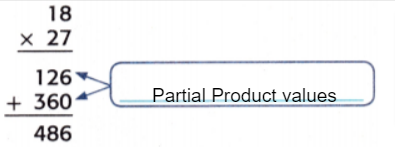
Question 4.
This property states that the grouping of the factors does not change the product.
Answer: Associative property states that the grouping of factors does not change the product.
Question 5.
This property states that multiplying a sum by a number is the same as multiplying each addend by the number and then adding the products.
2 × 12 = 2 × (10 + 2)
= (2 × 10) + (2 × 2)
= 20 + 4
= 24
______________
Answer: Distributive Property states that multiplying a sum by a number is the same as multiplying each addend by the number and then adding the products.
Concept Check
Multiply.
Question 6.

Answer: 8100
Explanation: Given the values 90 and 90.
Now, we will find the product value.
So, the values are 90 and 90 is,
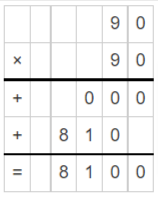
After multiplication, the value is 8100.
Question 7.

Answer: 2720
Explanation: Given the values 34 and 80.
Now, we will find the product value.
So, the values are 34 and 80 is,
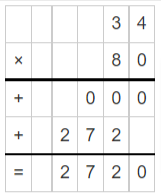
Hence, the final product value is 2720.
Question 8.

Answer: 1120
Explanation: Given the values 28 and 40.
Now, we will find the product value.
So, the values are 28 and 40 is,
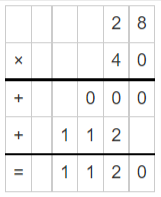
Thus, the product value is 1120.
Question 9.
![]()
Answer: 1350
Explanation: Given the values 45 and 30.
Now, we will find the product value.
So, the values are 45 and 30 is,
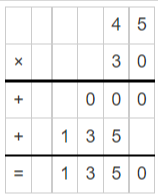
Hence, the product of 45 and 30 is 1350.
Estimate. Circle whether the estimate is greater than or less than the actual product.
Question 10.

greater than
less than
Answer: Less than
Explanation: Given the values 24 and 31.
Now, we will find the estimated product value.
The estimated value of 24 is 20 and the estimated value of 31 is 30.
So, the values are 20 and 30 is,
20 x 30 = 600.
The actual product value is,
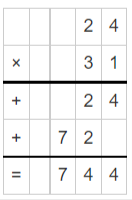
Therefore, the estimated product value is less than the actual value.
Question 11.

greater than
less than
Answer: Greater than
Explanation: Given the values 48 and 89.
Now, we will find the estimated product value.
The estimated value of 48 is 50 and the estimated value of 89 is 90.
So, the values are 50 and 90 is,
50 x 90 = 4500.
The actual product value is,

The actual product value is 4272.
Hence, the estimated product value is greater than the actual product value.
Question 12.

greater than
less than
Answer: Greater than
Explanation: Given the values 37 and 66.
Now, we will find the estimated product value is less than or greater than the actual product value.
The estimated value of 37 is 40 and the estimated value of 66 is 70.
So, the values are 40 and 70 is,
40 x 70 = 2800.
The actual product value is,

The actual product value is 2442.
Therefore, the estimated product value is greater than the actual value.
Question 13.

greater than
less than
Answer: Less than
Explanation: Given the values 52 and 84.
Now, we will find the estimated product value less than or greater than the actual value.
The estimated value of 52 is 50 and the estimated value of 84 is 80.
So, the values are 50 and 80 is,
50 x 80 = 4000.
The actual product value is,

The actual value is 4368.
Thus, the estimated value is less than the actual value.
Multiply.

Question 14.

Answer: 2898
Explanation: Given the values 63 and 46.
Now, we will find the product value.
So, the values are 63 and 46 is,
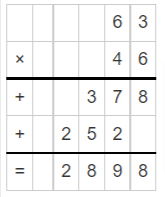
Hence, the product value is 2898.
Question 15.

Answer: 884
Explanation: Given the values 26 and 34.
Now, we will find the product value.
So, the values 26 and 34 is,
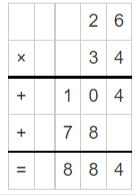
Hence, the final product value is 884.
Question 16.

Answer: 3528
Explanation: Given the values 72 and 49.
Now, we will find the product value.
So, the values are 72 and 49 is,

After multiplication, the product value is 3528.
Question 17.

Answer: 2255
Explanation: Given the values 55 and 41.
Now, we will find the product value.
So, the values are 55 and 41 is,
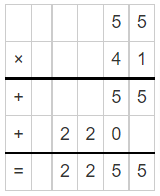
Therefore, the product value is 2255.
Problem Solving
Question 18.
A football coach orders 30 jerseys for his football team. The jerseys cost $29 each. What is the total cost of the jerseys?
Answer: The total cost of the jerseys is $870.
Explanation: Given the data,
A football coach orders 30 jerseys for his football team.
The jerseys cost $29 each.
Now, we will find the total cost of the jerseys.
So, the values are 30 and 29,
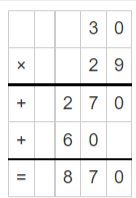
Hence, the total cost of the jerseys is $890.
Question 19.
Julio scores 18 points in each basketball game. If there are 14 games in a season and Julio continues to score 18 points each game, how many points will Julio score?
Answer: Julio’s score points will be 252.
Explanation: Given that,
Julio scores 18 points in each basketball game.
If there are 14 games in a season.
Julio continues to score 18 points each game.
Now, we will find out how many points will Julio score.
So, the values are 18 and 14,
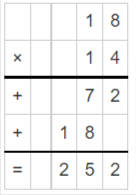
Hence, the total points julio scored is 252.
Question 20.
There are 30 students in each class. There are 27 classrooms. How many students are there altogether?
Answer: 810 students are there altogether.
Explanation: As given in the question, the data is
There are 30 students in each class.
There are 27 classrooms.
Now, we need to find out how many students are there altogether.
So, the values are 30 and 27 is,
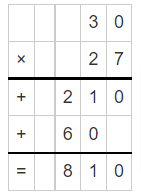
Therefore, all together students in a classroom is 810.
Question 21.
Tamara makes $12 an hour. She worked 28 hours this week. About how much money will she make?
Answer: She will make $336.
Explanation: Given the data is,
Tamara makes $12 an hour.
She worked 28 hours this week.
Now, we will find out how much money will she make.
So, the values are 12 and 28,
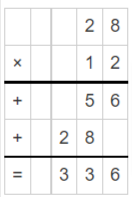
Hence, the total money she will make is $336.
Question 22.
Austin’s allowance is $15 per week. He spends $4 each week on baseball cards. How much money will Austin have at the end of 12 weeks?
Answer: $132 will Austin have at the end of 12 weeks.
Explanation: Given that,
Austin’s allowance is $15 per week.
He spends $4 each week on baseball cards.
Now, we need to find out how much money will Austin have at the end of 12 weeks.
So, the value is $15 – $4 = 11.
At the end of 12 weeks, Austin’s remaining money is,
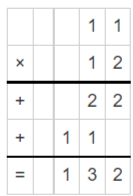
Hence, Austin has $132 at the end of 12 weeks.
Test Practice
Question 23.
A jumbo can of vegetables has 36 servings. How many servings of vegetables are in 18 cans?
A. 648 servings
B. 324 servings
C. 608 servings
D. 54 servings
Answer: Option A
Explanation: Given the data is,
A jumbo can of vegetables has 36 servings.
Now, we will find out how many servings of vegetables are in 18 cans.
So, the values are 36 and 18,

Hence, 648 servings of vegetables are in 18 cans. Therefore, option A is correct.
Reflect
Use what you learned about multiplying with two-digit numbers to complete the graphic organizer.
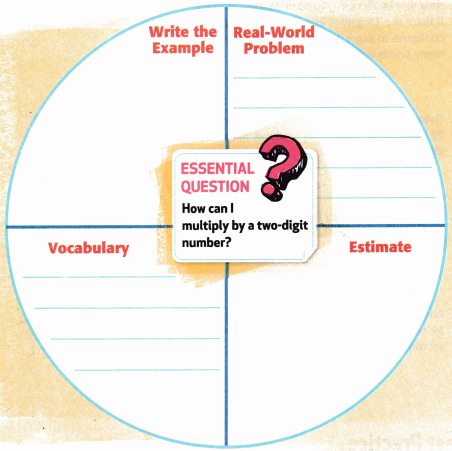
Reflect on the ESSENTIAL QUESTION. Write your answer below.
Answer: The following are the steps to multiply a two-digit number,
Step 1: Estimate the product using the nearest ‘tens’ to verify the answer.
Step 2: Multiply any one of the numbers by the ‘ones’ digit of the second number.
Step 3: Multiply the number by the ‘tens’ digit of the number.
The real-world example problem is,
Example: In a packet, there are 40 chocolates. We have 9 packets. How many total chocolates do we have?
Solution: Given that,
In a packet, there are 40 chocolates.
We have 9 packets.
Now, we will find out the estimated and actual value of how many total chocolates we have.
The estimated value of 40 is 40 and the estimated value of 9 is 10.
So, the product of estimation is 40 x 10 = 400.
The Actual product value of 40 and 9,
i.e., 40 x 9 = 360.
Therefore, we have a total number of chocolates is 80 Chocolates.